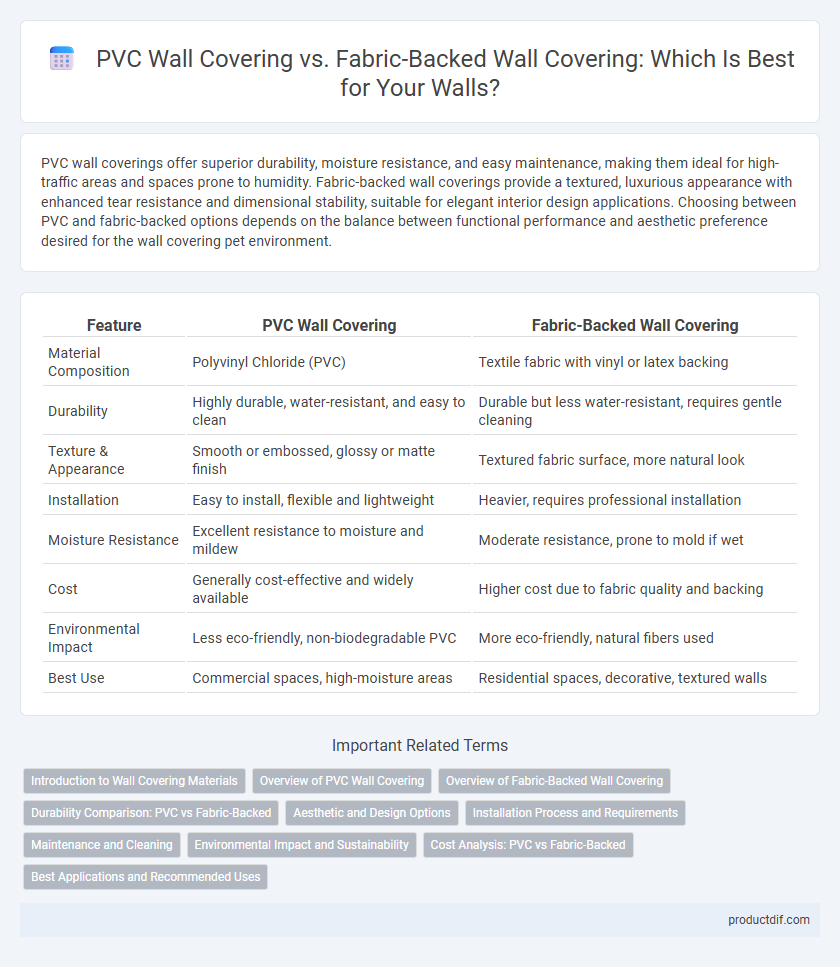PVC wall coverings offer superior durability, moisture resistance, and easy maintenance, making them ideal for high-traffic areas and spaces prone to humidity. Fabric-backed wall coverings provide a textured, luxurious appearance with enhanced tear resistance and dimensional stability, suitable for elegant interior design applications. Choosing between PVC and fabric-backed options depends on the balance between functional performance and aesthetic preference desired for the wall covering pet environment.
Table of Comparison
| Feature | PVC Wall Covering | Fabric-Backed Wall Covering |
|---|---|---|
| Material Composition | Polyvinyl Chloride (PVC) | Textile fabric with vinyl or latex backing |
| Durability | Highly durable, water-resistant, and easy to clean | Durable but less water-resistant, requires gentle cleaning |
| Texture & Appearance | Smooth or embossed, glossy or matte finish | Textured fabric surface, more natural look |
| Installation | Easy to install, flexible and lightweight | Heavier, requires professional installation |
| Moisture Resistance | Excellent resistance to moisture and mildew | Moderate resistance, prone to mold if wet |
| Cost | Generally cost-effective and widely available | Higher cost due to fabric quality and backing |
| Environmental Impact | Less eco-friendly, non-biodegradable PVC | More eco-friendly, natural fibers used |
| Best Use | Commercial spaces, high-moisture areas | Residential spaces, decorative, textured walls |
Introduction to Wall Covering Materials
PVC wall coverings offer durability, moisture resistance, and ease of maintenance, making them ideal for high-traffic or humid areas. Fabric-backed wall coverings provide enhanced texture, breathability, and aesthetic appeal, often preferred for residential or low-traffic spaces requiring a softer feel. Both materials serve distinct functional and decorative purposes, influencing choice based on environment and design requirements.
Overview of PVC Wall Covering
PVC wall coverings consist of polyvinyl chloride films that offer exceptional durability, moisture resistance, and easy maintenance, making them ideal for high-traffic or humid environments. These coverings provide a wide range of design possibilities with vibrant colors and textures while ensuring excellent stain and abrasion resistance. Their non-porous surface also contributes to enhanced hygiene, commonly used in healthcare and commercial settings.
Overview of Fabric-Backed Wall Covering
Fabric-backed wall covering features a reinforced textile layer that enhances durability and resistance to impact and abrasion, making it ideal for high-traffic areas. This type of wall covering offers superior dimensional stability and improved adhesion compared to standard PVC wall coverings, ensuring long-lasting performance. Its textured surface provides an elegant, sophisticated aesthetic while also enabling better sound absorption and insulation properties.
Durability Comparison: PVC vs Fabric-Backed
PVC wall covering offers superior durability due to its resistance to moisture, stains, and wear, making it ideal for high-traffic or humid environments. Fabric-backed wall coverings provide enhanced flexibility and tear resistance but may be less resistant to stains and moisture, requiring careful maintenance. When durability is the primary concern, PVC wall coverings typically outperform fabric-backed options in longevity and ease of cleaning.
Aesthetic and Design Options
PVC wall coverings offer a wide range of vibrant colors and patterns, providing durable and easy-to-clean surfaces ideal for high-traffic areas. Fabric-backed wall coverings deliver a textured, luxurious finish with enhanced depth and richness, perfect for adding warmth and sophistication to interior spaces. Both options support various design preferences, but fabric-backed coverings excel in creating elegant, tactile aesthetics while PVC sheets focus on versatility and practicality.
Installation Process and Requirements
PVC wall coverings feature a smooth, waterproof surface that simplifies installation using standard adhesives and require minimal surface preparation, making them ideal for high-moisture environments. Fabric-backed wall coverings demand more precise application techniques, often requiring specialized primers and strong adhesives to ensure proper adhesion and to accommodate their textured, flexible backing. Installation of fabric-backed options typically involves careful alignment to prevent stretching or distortion, whereas PVC coverings offer greater ease and speed in handling and trimming.
Maintenance and Cleaning
PVC wall coverings offer superior resistance to stains, moisture, and chemicals, making them easier to clean with simple wiping or mild detergent solutions. Fabric-backed wall coverings require more delicate maintenance, often needing gentle vacuuming and specialized cleaning agents to avoid damage or discoloration. Regular upkeep of fabric-backed options is essential to preserve their texture and appearance, whereas PVC surfaces generally withstand harsh cleaning without deterioration.
Environmental Impact and Sustainability
PVC wall coverings often pose significant environmental concerns due to their reliance on non-renewable petroleum resources and challenges in recycling, leading to long-term ecological impacts. In contrast, fabric-backed wall coverings typically utilize natural fibers or recyclable materials, offering enhanced biodegradability and a reduced carbon footprint. Choosing fabric-backed options supports sustainability by minimizing toxic emissions during production and facilitating more eco-friendly disposal processes.
Cost Analysis: PVC vs Fabric-Backed
PVC wall coverings generally offer a lower initial cost compared to fabric-backed options, making them budget-friendly for large-scale projects. Fabric-backed wall coverings tend to have higher upfront expenses but provide enhanced durability and longer lifespan, which may reduce replacement and maintenance costs over time. Evaluating total cost of ownership reveals that while PVC is economical short-term, fabric-backed materials often deliver greater value through longevity and resilience in high-traffic environments.
Best Applications and Recommended Uses
PVC wall coverings excel in high-traffic and moisture-prone areas such as hospitals, kitchens, and commercial spaces due to their durability, water resistance, and ease of cleaning. Fabric-backed wall coverings are ideal for residential interiors, hotels, and offices where aesthetics and texture are prioritized, offering enhanced durability and sound insulation. Best applications for PVC involve environments requiring frequent maintenance, while fabric-backed options suit spaces needing sophisticated design with moderate durability.
PVC wall covering vs Fabric-backed wall covering Infographic

 productdif.com
productdif.com